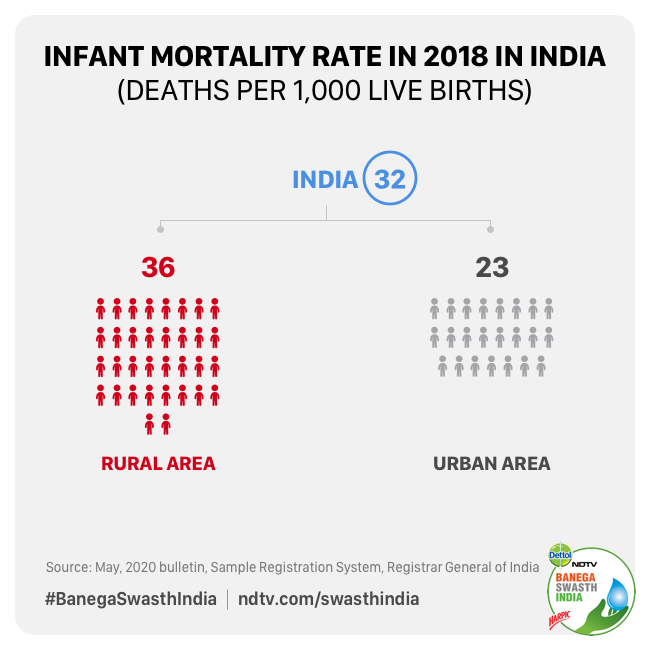Highlights
- IMR is a vital indicator for health and human development: Experts
- In 2018, Madhya Pradesh had maximum IMR and Nagaland minimum
- IMR in females is more than in males in the country
New Delhi: Infant mortality rate (IMR) in the country has dropped from 33 infant deaths per 1,000 live births in 2017 to 32 during 2018. This denotes that one in every 31 infants die within the first year of their life. May, 2020 bulletin of Sample Registration System (SRS), released by the Registrar General of India, based on data collected for 2018, shows that the IMR for rural areas was 36 deaths per 1,000 live births while in the urban areas it was 23 deaths per 1,000 live births. Infant mortality is the death of children under the age of one year. And Infant Mortality Rate is measured as the number of infant deaths per 1,000 live births.
Also Read: Child, Maternal Malnutrition Led To 68 Per Cent Under-Five Fatalities In India
SRS is the national demographic survey that provides estimates of birth rate, death rate and other fertility and mortality indicators, annually since 1964. The present sample consists of 81 lakh population, spread across all States and Union territories.
The data further highlights that the country has made progress in terms of IMR as it has declined from 50 to 32 deaths per 1,000 live births in the last decade. Even though the IMR has reduced in 2018 compared to the previous year, the SRS data shows that it continues to be slightly higher among girls than boys. While it is 32 deaths per 1,000 live births among boys, IMR among girls is 33 deaths per 1,000 live births.
The SRS IMR data further shows that Madhya Pradesh with 48 infant deaths per 1,000 live births has the worst infant mortality rate in the country while Nagaland with 4 infant deaths per 1,000 live births has the best. MP’s IMR, in fact, has worsened slightly from 2017 when it stood at 47 deaths. The urban-rural differential in MP is huge with the rural IMR at 51, while the urban IMR at 32. Kerala is the best performer among large states with IMR 7 deaths per 1,000 live births. The largest decline in IMR has been registered by Mizoram with a decline from 15 to 5.
Also Read: COVID-19 Could Cause Hundreds Of Thousands Of Additional Child Death: United Nations
What Does The IMR Data Indicates And What Jeopardises The Lives Of Children In The Country?
According to Dr. Dileep Mavalankar, Director, Indian Institute Of Public Health, Gandhinagar, the IMR of a country indicates the status of health and human development. It shows how well public health infrastructure is able to take care of mother and child during the first 1,000 days which start from the conception of the baby, he said. He further added that maternal education plays an important role in infant and child mortality and thus IMR is also an indicator of how much importance is given to female education in a country.
Dr. Mavalankar also pointed out that in the country, the SRS registration system should include all births and deaths to provide a clearer picture of the mortality indicators which is crucial for understanding the state of human development in the country and effective planning towards improving it.
Dr. S. P. Singh, Professor, Department of Humanities and Social Sciences, Indian Institute of Technology, Roorkee said that poor quality of preventive and primary healthcare system in the country jeopardises the lives of children. He asserted that in most cases, child deaths happen due to preventable infections like diarrhoea and pneumonia which can be treated at the primary level. He further said,
Infant deaths are a result of social issues like malnutrition, anaemia, lack of access to sanitation, safe drinking water, and hygiene, lack of access to immunization, poor education among parents, especially mothers and gender discrimination. The economic disparity among districts is a huge problem too when it comes to child survival as the states that are more developed have better health infrastructure in both rural and urban areas as compared to the lesser developed districts. Within a district, the IMR throws light at the rural-urban divide in terms of health facilities. The rural areas are suffering from an acute shortage of health infrastructure and healthcare personnel including ASHA (Accredited Social Health Activist) and ANM (Auxiliary Nurse Midwifery).
According to Dr. Singh, many infant deaths can be prevented by widening the reach of good quality antenatal care, institutional births, postnatal care for the mother and the baby, and care of sick newborns. He added,
Deaths of infants below the age of one year can be prevented by methods like breastfeeding in the first hour of birth, exclusive breastfeeding in the first six months, skin-to-skin contact with mother, temperature monitoring, and providing care against infections and breathing difficulties.
He highlighted that one of the reasons for the reduction in IMR may be the increase in institutional deliveries.
Dr. Singh further asserted that the country is still far behind its neighbours in terms of IMR as the infant mortality rate in China stands at 7, in Sri Lanka, it is less than 7, in Bangladesh, it is 25 and Nepal it is 26.
Also Read: Top Highlights: Nutrition India Programme Annual Report 2019
[corona_data_new]





















